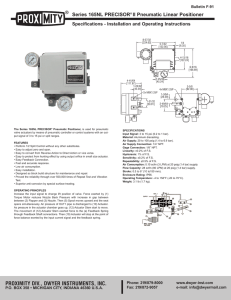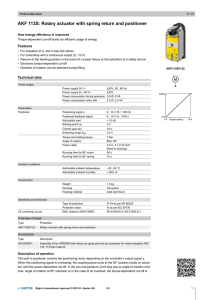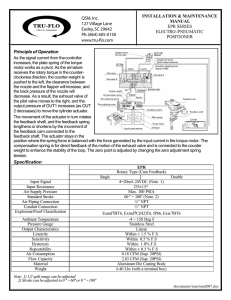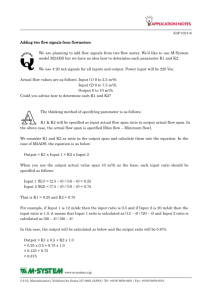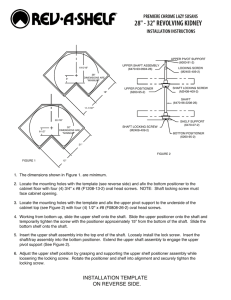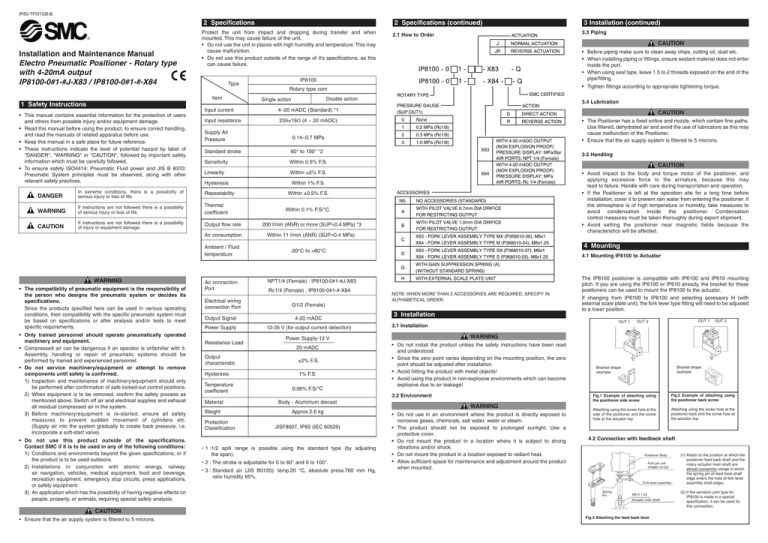
IP80-TFI01GB-B
2 Specifications (continued)
2 Specifications
Installation and Maintenance Manual
Electro Pneumatic Positioner - Rotary type
with 4-20mA output
IP8100-0#1-#J-X83 / IP8100-0#1-#-X84
Protect the unit from impact and dropping during transfer and when
mounted. This may cause failure of the unit.
• Do not use the unit in places with high humidity and temperature. This may
cause malfunction.
• Do not use this product outside of the range of it's specifications, as this
can cause failure.
3.3 Piping
2.1 How to Order
CAUTION
• Before piping make sure to clean away chips, cutting oil, dust etc.
• When installing piping or fittings, ensure sealant material does not enter
inside the port.
• When using seal tape, leave 1.5 to 2 threads exposed on the end of the
pipe/fitting.
IP8100
Type
• Tighten fittings according to appropriate tightening torque. 3
Rotary type cam
Item
1 Safety Instructions
• This manual contains essential information for the protection of users
and others from possible injury and/or equipment damage.
• Read this manual before using the product, to ensure correct handling,
and read the manuals of related apparatus before use.
• Keep this manual in a safe place for future reference.
• These instructions indicate the level of potential hazard by label of
"DANGER", "WARNING" or "CAUTION", followed by important safety
information which must be carefully followed.
• To ensure safety ISO4414: Pneumatic Fluid power and JIS B 8370:
Pneumatic System principles must be observed, along with other
relevant safety practices.
Input current
4~20 mADC (Standard) *1
Input resistance
235±15Ω (4 ~ 20 mADC)
Supply Air
Pressure
0.14~0.7 MPa
Standard stroke
60° to 100° *2
Sensitivity
Within 0.5% F.S.
Linearity
Within ±2% F.S.
Hysteresis
Within 1% F.S.
DANGER
In extreme conditions, there is a possibility of
serious injury or loss of life.
Repeatability
WARNING
If instructions are not followed there is a possibility
of serious injury or loss of life.
Thermal
coefficient
CAUTION
If instructions are not followed there is a possibility
of injury or equipment damage.
Output flow rate
200 I/min (ANR) or more (SUP=0.4 MPa) *3
Air consumption
Within 11 l/min (ANR) (SUP=0.4 MPa)
Ambient / Fluid
temperature
WARNING
• The compatibility of pneumatic equipment is the responsibility of
the person who designs the pneumatic system or decides its
specifications.
Since the products specified here can be used in various operating
conditions, their compatibility with the specific pneumatic system must
be based on specifications or after analysis and/or tests to meet
specific requirements.
• Only trained personnel should operate pneumatically operated
machinery and equipment.
• Compressed air can be dangerous if an operator is unfamiliar with it.
Assembly, handling or repair of pneumatic systems should be
performed by trained and experienced personnel.
• Do not service machinery/equipment or attempt to remove
components until safety is confirmed.
1) Inspection and maintenance of machinery/equipment should only
be performed after confirmation of safe locked-out control positions.
2) When equipment is to be removed, confirm the safety process as
mentioned above. Switch off air and electrical supplies and exhaust
all residual compressed air in the system.
3) Before machinery/equipment is re-started, ensure all safety
measures to prevent sudden movement of cylinders etc.
(Supply air into the system gradually to create back pressure, i.e.
incorporate a soft-start valve).
• Do not use this product outside of the specifications.
Contact SMC if it is to be used in any of the following conditions:
1) Conditions and environments beyond the given specifications, or if
the product is to be used outdoors.
2) Installations in conjunction with atomic energy, railway,
air navigation, vehicles, medical equipment, food and beverage,
recreation equipment, emergency stop circuits, press applications,
or safety equipment.
3) An application which has the possibility of having negative effects on
people, property, or animals, requiring special safety analysis.
Air connection
Port
Electrical wiring
connection Port
3.5 Handling
CAUTION
• Avoid impact to the body and torque motor of the positioner, and
applying excessive force to the armature, because this may
lead to failure. Handle with care during transportation and operation.
• If the Positioner is left at the operation site for a long time before
installation, cover it to prevent rain water from entering the positioner. If
the atmosphere is of high temperature or humidity, take measures to
avoid condensation inside the positioner. Condensation
control measures must be taken thoroughly during export shipment,
• Avoid setting the positioner near magnetic fields because the
characteristics will be affected.
4 Mounting
-20°C to +80°C
4.1 Mounting IP8100 to Actuator
NPT1/4 (Female) : IP8100-0#1-#J-X83
Rc1/4 (Female) : IP8100-0#1-#-X84
NOTE: WHEN MORE THAN 2 ACCESSORIES ARE REQUIRED, SPECIFY IN
ALPHABETICAL ORDER.
G1/2 (Female)
Power Supply
12-35 V (for output current detection)
3 Installation
Output
characteristic
±2% F.S.
Hysteresis
1% F.S.
0.06% F.S/°C
OUT 1
Body - Aluminium diecast
Weight
Approx 2.6 kg
JISF8007, IP65 (IEC 60529)
* 1 :1/2 split range is possible using the standard type (by adjusting
the span).
* 2 : The stroke is adjustable for 0 to 60° and 0 to 100°.
* 3 : Standard air (JIS B0120): temp.20 °C, absolute press.760 mm Hg,
ratio humidity 65%.
OUT 2
WARNING
• Do not use in an environment where the product is directly exposed to
corrosive gases, chemicals, salt water, water or steam.
• The product should not be exposed to prolonged sunlight. Use a
protective cover.
• Do not mount the product in a location where it is subject to strong
vibrations and/or shock.
• Do not mount the product in a location exposed to radiant heat.
• Allow sufficient space for maintenance and adjustment around the product
when mounted.
Bracket shape
example
Bracket shape
example
Fig.1 Example of attaching using
the positioner side screw
Fig.2 Example of attaching using
the positioner back screw
Attaching using the screw hole at the
side of the positioner and the screw
hole at the actuator top.
Attaching using the screw hole at the
positioner back and the screw hole at
the actuator top.
4.2 Connection with feedback shaft
Positioner Body
Fork pin unit
(P3680 10-23)
Fork lever assembly
Spring
Pin
M8 X 1.25
Actuator main shaft
CAUTION
• Ensure that the air supply system is filtered to 5 microns.
OUT 1
OUT 2
WARNING
• Do not install the product unless the safety instructions have been read
and understood.
• Since the zero point varies depending on the mounting position, the zero
point should be adjusted after installation.
• Avoid hitting the product with metal objects!
• Avoid using the product in non-explosive environments which can become
explosive due to air leakage!
3.2 Environment
Material
The IP8100 positioner is compatible with IP6100 and IP610 mounting
pitch. If you are using the IP6100 or IP610 already, the bracket for these
positioners can be used to mount the IP8100 to the actuator.
If changing from IP6100 to IP8100 and selecting accessory H (with
external scale plate unit), the fork lever type fitting will need to be adjusted
to a lower position.
3.1 Installation
Power Supply-12 V
20 mADC
Protection
Classification
CAUTION
• The Positioner has a fixed orifice and nozzle, which contain fine paths.
Use filtered, dehydrated air and avoid the use of lubricators as this may
cause malfunction of the Positioner.
• Ensure that the air supply system is filtered to 5 microns.
Within 0.1% F.S/°C
4-20 mADC
Temperature
coefficient
3.4 Lubrication
Within ±0.5% F.S.
Output Signal
Resistance Load
Installation (continued)
Double action
Single action
3 Installation (continued)
Fig.3 Attaching the feed back lever
(1) Attach to the position at which the
positioner feed back shaft and the
rotary actuator main shaft are
almost concentric (range in which
the spring pin of feed back shaft
edge enters the hole of fork lever
assembly shaft edge).
(2) If the serration joint type for
IP8100 is made in a special
specification, it can be used for
this connection.
IP80-TFI01GB-B
4 Mounting (continued)
5 Adjustment (continued)
(4)
4.3 Cam attaching procedure
CAUTION
Counterclockwise
Clockwise
(5)
(2)
(3)
CAUTION
(2)
Cam reference
Bearing
(3)
(Normal actuation)
Fig.4 Example of cam attaching
(1) Use the DA face of the cam to turn the actuator
main shaft clockwise (viewed from the positioner
front cover side) at the time of input signal
increase. Use the RA face to turn it
counter-clockwise (reverse actuation). Correctly
attach the cam to the flange part of feed back
shaft.
(2) Attach the cam in the procedure of loosening the
hexagonal nut with flange first, setting the used
actuator to the starting position and then setting
the cam reference line and the bearing contact
point of span adjusting arm unit to the matching
position.
(3) Do not apply the supply pressure when attaching
the cam as otherwise it is very dangerous.
(4) When the positioner is shipped from the factory,
the cam is tentatively tightened to the shaft.
Be sure to firmly lock the cam to the lock nut
[tightening torque 2.0 ~ 2.5 Nm.
(4)
(5)
(6)
FIG.5 Direct / Reverse actuation
5 Adjustment
CAUTION
Check the following prior to starting the adjustment
(1) Check that the pipeline is correctly connected with the pressure
supply port and OUT1 and OUT2 ports.
(2) Check that the actuator and positioner are sturdily connected.
(3)
Check for correct use of the cam face (normal or reverse) and that
theflange nut is firmly locked (refer to Fig.5).
Check that the wires are connected correctly to the (+), (-)
and Ground terminals.5 Adjustment (continued)
Hex. nut with flange
(1)
(Reverse actuation)
5 Adjustment (continued)p
For this positioner, span and zero point adjustment of each actuator is
necessary. Adjustment should be carried out based on each
actuator size.
Keep in mind that the span and zero point adjustment interfere with
each other.
Characteristics change due to change of mounting position, ambient
temperature and supply pressure.
If the positioner takes a long time to operate after initial adjustment,
check and adjust the product again.
Sensitive adjustment is effective for only double acting actuators.
Manual change function is effective for single acting actuators which are
controlled by using OUT1
5.1 Electrical wiring
This product has a potentiometer and p.c.board built into it. This is for
confirming the actuator's opening by a 4-20 mADC output signal produced by
supplying initial power to the pcb. This supply power can be set freely
between 12-35 VDC.
According to the operating direction of the actuator or feed back lever, the
clockwise potentiometer direction gives regular operation, and the counterclockwise direction gives opposite operation.
5.1.1 Wiring of Input signal & Power source
(1) Connect the input signal wires (for positioner control) to 1 (+) and 2 (-)
of the terminal board in the terminal box.
(2) Connect the power source wires (for powering the output current
detection circuit) to 3 (+) and 4 (-) of the terminal board.
(3) Connect an ammeter in series between (+) side and 3 (+) of terminal
board, or (-) side and 4 (-) terminals.
6 Maintenance
Adjust the zero / span with the variable resistors on the p.c.board (refer
to Fig.8).
Adjust the zero point and span alternately and repeatedly as they
interact with each other. Since this variable resistor can be wound
endlessly, do not overwind, otherwise internal equipment might be
damaged. Adjust while monitoring the output signal.
5.3 Change of Operating Direction (IP8100 Rotary)
(1) The Output signal is configured to increase in normal operation
(clockwise) when shipped from the factory.
(2) To apply the positioner in reverse operation (counter-clockwise), specify
the
accessory
classification
JR
when
ordering.
Alternatively, to change the operation of the delivered product,
re-arrange the cam to the opposite side and switch the terminals A and
C (refer to Fig.7), to reverse the direction of the output signal.
(3) Loosen the potentiometer set screw while applying power and
ensuring an output current, then rotate the potentiometer 10-20° away
from the dead band (see Fig.8) to decide the start point. Settle the
potentiometer with the set screws again.
CAUTION
(Setting Potentiometer)
(1)
The Output signal does not operate at the deadband of the
potentiometer.
(2)
If the start point is set at 4 mADC, at the border line of the resistance
range and the deadband, malfunction may occur.
(3)
If the Output current is 0 mADC during opening, the potentiometer may
be set across the border between the resistance range and the
deadband. Follow the steps above noting the potentiometer rotation
direction.
(4)
When the rotary positioner is used in reverse action, adjust the
potentiometer fixing position to avoid clashing of the cam and
potentiometer lead wire.
CAUTION
• After installation, repair and disassembly, connect compressed air and
perform a proper function test and leak test. If bleed noise is louder than
the initial state, or operation is abnormal, stop operation and check if
the installation is correct.
CAUTION
• Check if supply air is clean or not. Inspect compressed air cleaning
system periodically so that dust, oil and humidity do not enter the unit.
This can cause malfunction or failure of the unit.
• If handled improperly, compressed air can be dangerous. Maintenance
and replacement of unit parts should only be performed by trained and
experienced personnel for instrumentation equipment, as well as
following the product specifications.
• Check the positioner once a year. When an excessively worn
diaphragm, O-ring or other seals of any unit that has been damaged is
found, replace with new ones. Treatment at an early stage is especially
important if the positioner is used in a place of severe environment,
such as coastal areas.
• Before removing the positioner for maintenance, or replacing unit parts
after installation, ensure the supply pressure is shut off and all residual
air pressure is released from the piping.
• When the fixed orifice is clogged with carbon particles or other material,
remove the pilot valve Auto/Manual change over screw (built in fixed
aperture) and clean it by carefully inserting a 0.3mm diameter wire into
the aperture.
• When disassembling the pilot valve, coat the O-ring of the sliding
section with grease. (Use TORAY SILICONE SH45 grease).
• Check for air leaks from the compressed air piping. Air leaks could
reduce the performance characteristics of the positioner. Air is normally
discharged from a bleed port, but this is necessary air consumption
based on the construction of the positioner, and is not abnormal if the
air consumption is within the specified range.
Check for locking of the auto / manual changeover screw of the pilot
valve (fully tightened in the clockwise direction).
inside terminal box
user wiring
Input signal
4 ~ 20 mADC
2
3
power source
DC12 ~ 35V
4
R
power source
DC12 ~ 35
1
ammeter
r (internal
resistance)
terminal board
Fig.7 P.C board
Fig.8 Potentiometer (IP8100)
Allowable load resistance = R + r (internal resistance)
NOTE ! Allowable load resistance depends on supply voltage
(4)
The allowable load resistance is determined using the formula below.
Allowable load resistance = (Supply voltage-12V) / 20 mADC-(1)
Normal output current is not obtained if the load resistance value exceeds the
results of the formula. Please confirm internal resistance when selecting an
ammeter.
(1) Set the input current to 0% (4mADC in the standard specification) and turn
the zero adjusting knob by hand to set it to the actuator starting point.
(2) Then set the input current to 100% (20mADC in the standard specification)
and check the actuator stroke. At this point depending on the span being
too large or too small, loosen the lock screw and adjust the span as shown
in the illustration above.
(3) Set the input current to 0% and conduct the zero point adjudtment, as
shown in Step (1) again.
(4) Repeat the above operations until the predetermind stroke of the actuator
is obtained for the input current.
Fig.6 Zero /Span adjustment
*1 When the span adjusting screw is turned clockwise with a screwdriver, the span
decreases. When it is turned counter-clockwise, the span increases.
5.2 Zero / Span adjustment (Output)
Zero point / Span adjustment of the output current of the positioner (with
potentiometer) should be carried out after initial zero / span adjustments in
Fig.6.
This product requires zero / span adjustment of the output current according
to the actuators rotating angle (rotary type).
Please follow the procedure below:
(1) Set the actuator's output opening or stroke to 0% after adjusting the
zero / span.
7 Contact
AUSTRIA
BELGIUM
CZECH REP.
DENMARK
FINLAND
FRANCE
GERMANY
GREECE
HUNGARY
IRELAND
ITALY
(43) 2262 62280
(32) 3 355 1464
(420) 541 424 611
(45) 7025 2900
(358) 207 513513
(33) 1 6476 1000
(49) 6103 4020
(30) 210 271 7265
(36) 23 511 390
(353) 1 403 9000
(39) 02 92711
NETHERLANDS
NORWAY
POLAND
PORTUGAL
SLOVAKIA
SLOVENIA
SPAIN
SWEDEN
SWITZERLAND
UNITED KINGDOM
(31) 20 531 8888
(47) 67 12 90 20
(48) 22 211 9600
(351) 21 471 1880
(421) 2 444 56725
(386) 73 885 412
(34) 945 184 100
(46) 8 603 1200
(41) 52 396 3131
(44) 1908 563888
URL http://www.smcworld.com (Global) http://www.smceu.com (Europe)
Specifications are subject to change without prior notice from the manufacturer.
The descriptions of products in this document may be used by other companies.
© SMC Corporation All Rights Reserved.

